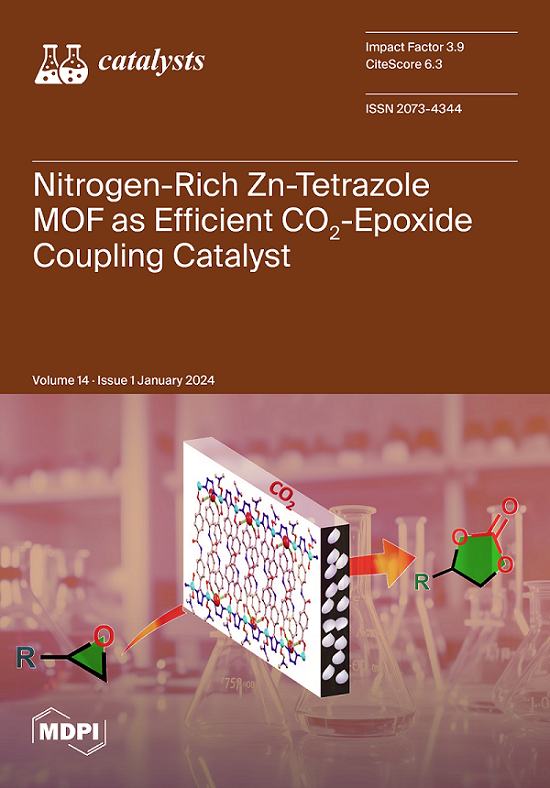Ultrasound/Chlorine: A Novel Synergistic Sono-Hybrid Process for Allura Red AC Degradation
IF 3.8
3区 化学
Q2 CHEMISTRY, PHYSICAL
引用次数: 1
Abstract
Herein, we present an original report on chlorine activation by ultrasound (US: 600 kHz, 120 W) for intensifying the sonochemical treatment of hazardous organic materials. The coupling of US/chlorine produced synergy via the involvement of reactive chlorine species (RCSs: Cl•, ClO• and Cl2•−), resulting from the sono-activation of chlorine. The degradation of Allura Red AC (ARAC) textile dye, as a contaminant model, was drastically improved by the US/chlorine process as compared to the separated techniques. A synergy index of 1.74 was obtained by the US/chlorine process for the degradation of ARAC (C0 = 5 mg·L−1) at pH 5.5 and [chlorine]0 = 250 mM. The synergistic index increased by up to 2.2 when chlorine concentration was 300 µM. Additionally, the synergetic effect was only obtained at pH 4–6, where HOCl is the sole chlorine species. Additionally, the effect of combining US and chlorine for ARAC degradation was additive for the argon atmosphere, synergistic for air and negative for N2. An air atmosphere could provide the best synergy as it generates a relatively moderate concentration of reactive species as compared to argon, which marginalizes radical–radical reactions compared to radical–organic ones. Finally, the US/chlorine process was more synergistic for low pollutant concentrations (C0 ≤ 10 mg·L−1); the coupling effect was additive for moderate concentrations (C0 ~ 20–30 mg·L−1) and negative for higher C0 (> 30 mg·L−1). Consequently, the US/chlorine process was efficiently operable under typical water treatment conditions, although complete by-product analysis and toxicity assessment may still be necessary to establish process viability.超声/氯:一种新型协同声-杂化工艺降解紫外光AC
在此,我们提出了一份关于超声波(US:600 kHz,120 W)激活氯以加强危险有机材料的声化学处理的原始报告。US/氯的耦合通过活性氯物种(RCS:Cl•、ClO•和Cl2•−)的参与产生协同作用,这是由氯的声激活引起的。与分离技术相比,US/氯工艺显著改善了Allura Red AC(ARAC)纺织染料作为污染物模型的降解。在pH 5.5和[氯]0=250mM的条件下,US/氯法降解ARAC(C0=5 mg·L−1)的协同指数为1.74。当氯浓度为300µM时,协同指数增加了2.2。此外,协同效应仅在pH为4-6时获得,其中HOCl是唯一的氯物种。此外,US和氯组合对ARAC降解的影响对氩气环境是相加的,对空气是协同的,对N2是负的。空气气氛可以提供最佳的协同作用,因为与氩相比,它产生相对中等浓度的反应物种,与自由基-有机反应相比,氩使自由基-自由基反应边缘化。最后,对于低污染物浓度(C0≤10 mg·L−1),US/氯过程具有更强的协同效应;中等浓度(C0~20–30 mg·L−1)的耦合效应是加性的,而较高浓度(>30 mg·L–1)的偶联效应是负性的。因此,US/氯工艺在典型的水处理条件下是有效操作的,尽管完整的副产物分析和毒性评估可能仍然是确定工艺可行性所必需的。
本文章由计算机程序翻译,如有差异,请以英文原文为准。
求助全文
约1分钟内获得全文
求助全文
来源期刊

Catalysts
CHEMISTRY, PHYSICAL-
CiteScore
6.80
自引率
7.70%
发文量
1330
审稿时长
3 months
期刊介绍:
Catalysts (ISSN 2073-4344) is an international open access journal of catalysts and catalyzed reactions. Catalysts publishes reviews, regular research papers (articles) and short communications. Our aim is to encourage scientists to publish their experimental and theoretical results in as much detail as possible. Therefore, there is no restriction on the length of the papers. The full experimental details must be provided so that the results can be reproduced.
 求助内容:
求助内容: 应助结果提醒方式:
应助结果提醒方式:


